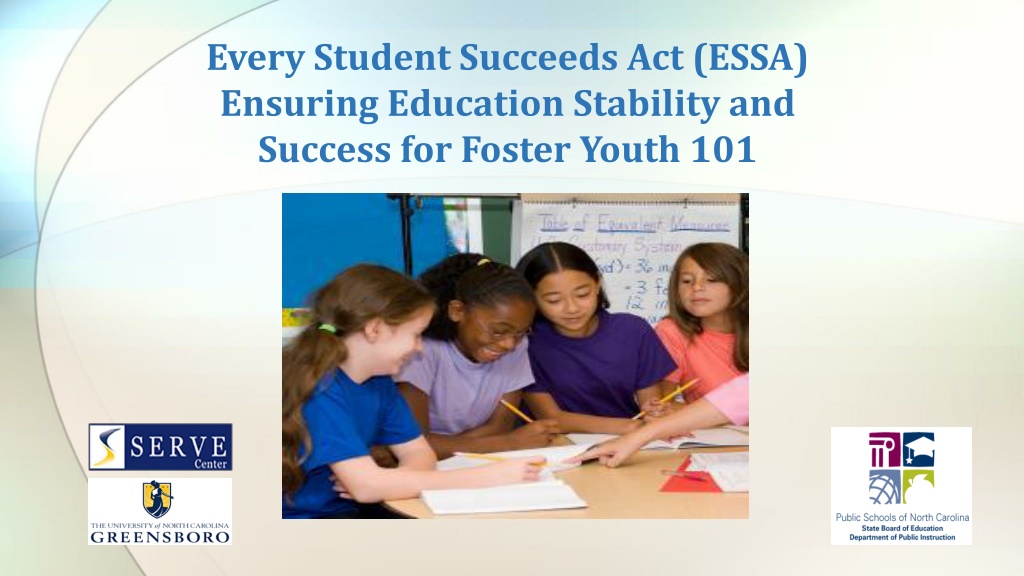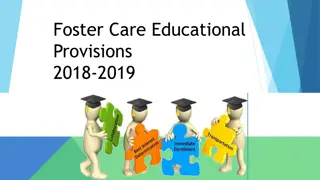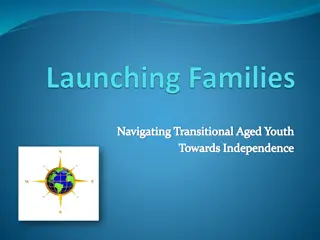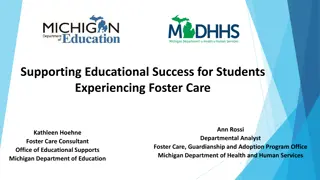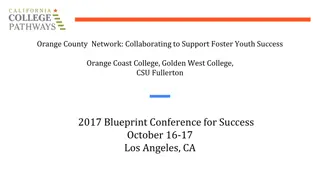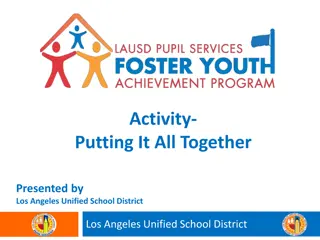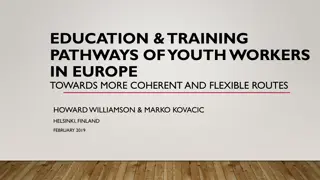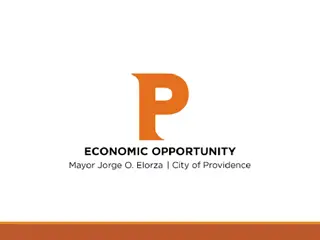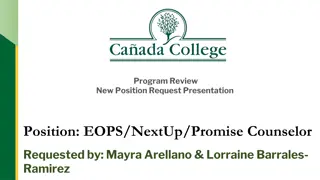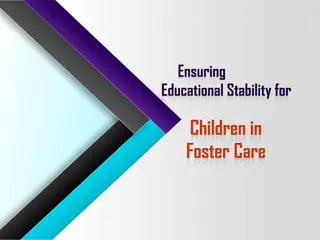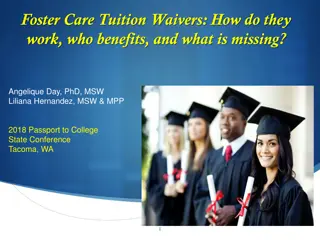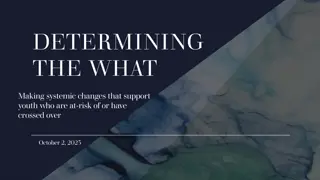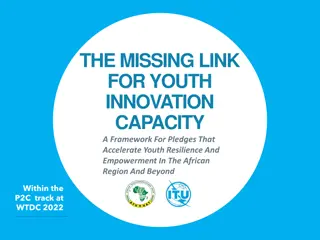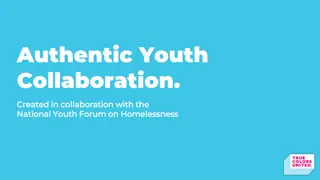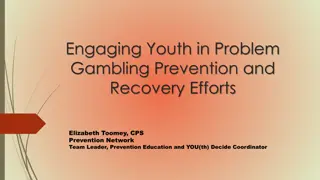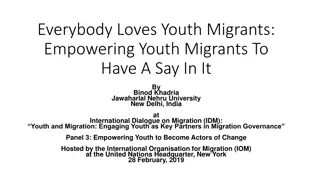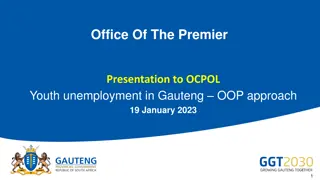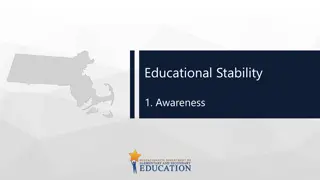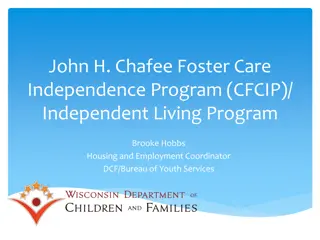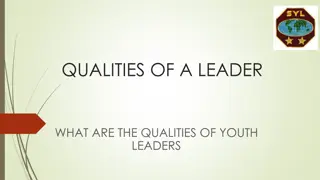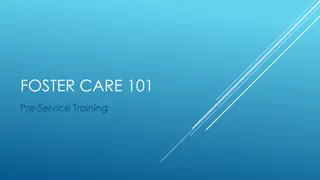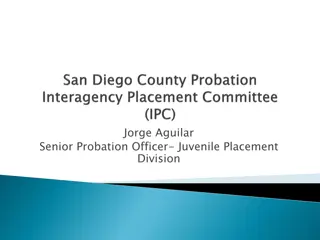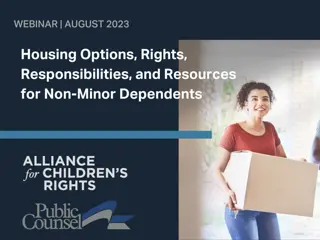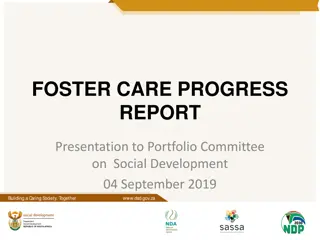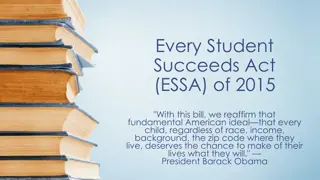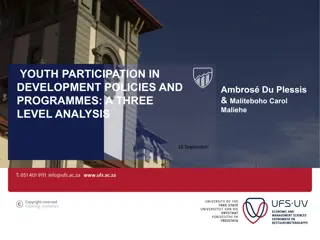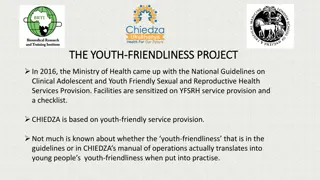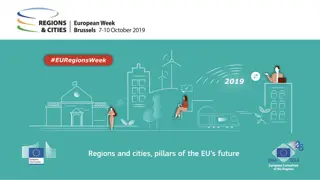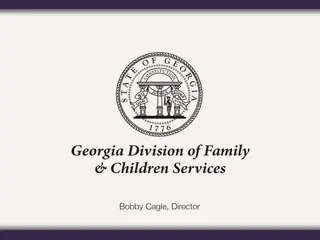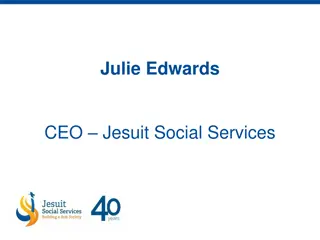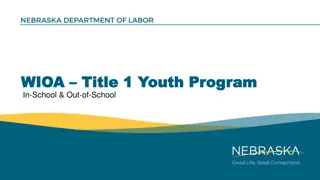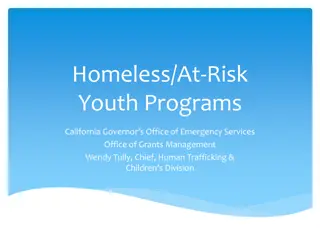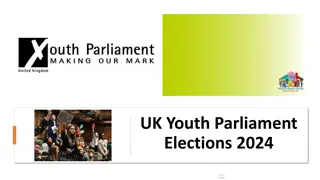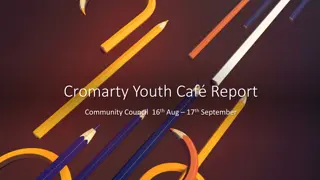Ensuring Education Stability for Foster Youth: Challenges and Solutions
Children and youth in foster care face significant educational challenges due to high mobility rates, trauma, and academic setbacks. These issues lead to lower graduation rates, academic achievement, and increased suspensions. The ESSA aims to promote school stability for foster youth to address these concerns and provide vital support for their educational success.
Download Presentation

Please find below an Image/Link to download the presentation.
The content on the website is provided AS IS for your information and personal use only. It may not be sold, licensed, or shared on other websites without obtaining consent from the author. Download presentation by click this link. If you encounter any issues during the download, it is possible that the publisher has removed the file from their server.
E N D
Presentation Transcript
Every Student Succeeds Act (ESSA) Ensuring Education Stability and Success for Foster Youth 101 Subtitle
Rationale for Promoting and prioritizing School Stability for children and youth in foster care
Children and youth in foster care represent some of our most vulnerable and highly mobile groups of students. Compared to their peers, children in foster care can experience: *More traumatic events *More unscheduled school changes *More delays in school enrollment *Lower graduation rates *Lower academic achievement *Higher rates of grade retention, chronic absenteeism, suspensions and expulsions
Foster Care Mobility and Education Average number of living arrangements during first foster care stay: 2.8 Percent of foster youth who change schools when entering care: 56%-75% Percent of 17-18 year-olds who have experienced 5+ school changes: 34% Average reading level of 17-18 year-olds: 7thgrade Likelihood of being absent from school: 2xs that of other students Likelihood of receiving special education services: 2.5-3.5x that of other students Likelihood of 17-18 year old receiving out-of-school suspension: 2xs that of other students Reference: Better Care Network - National Fact Sheet on Children in Foster Care
Foster Care and Education Percent of foster youth who complete high school by age 18 is only 50% Percent of foster youth who graduate from high school and attend college: 20% Percent of 17-18 year old foster youth who want to go to college: 84% Optimistic studies show just 6% will earn their bachelor s degrees. Reference: Better Care Network - National Factsheet of Children in Foster Care Chapin Hall Issue Brief
What can children in foster care lose when they have to change schools? Close and meaningful relationships with friends Significant relationships with supportive adults Class credits Extra-curricular activity involvement and experiences (band, sports, student government, various types of clubs) Educational services (potentially)
Number of Children in Foster Care According to the Department of Health and Human Services (HHS), 400,000 youth are in foster care in any given year. In North Carolina, from April 2016-March 2017, 16,437 children were in custody and care of child welfare. (Source http://ssw.unc.edu/ma/)
Annual NC Data on Total Number of Children by Age in Custody Over Time http://ssw.unc.edu/ma/
How many children are in custody in my district? The Management Assistance for Child Welfare, Work First, and Food & Nutrition Services in North Carolina has all of the information broken down http://ssw.unc.edu/ma/
Key Federal Provisions Brief history building up to ESSA implementation December 10, 2016
Fostering Connections to Success and Increasing Adoptions Act, 2008 Title IV-B/IV-E agencies must make assurances that: The child s placement takes into account the appropriateness of the current educational setting and the proximity to the school of origin; The CWA has coordinated with local education agencies (LEAs) to ensure that a child in foster care remains in his or her school of origin if it is in the child s best interest; and If remaining at the school of origin is not in the child s best interest, the child is immediately enrolled in a new attendance area school and records are transferred to the new school.
Uninterrupted Scholars Act (2013) USA creates a new exception under FERPA that makes it easier for schools to release a child s education records to child welfare agencies without the prior written consent of the parents. USA eliminates the requirement that education agencies notify parents before education records are released pursuant to a court order to any individual, when the parent is a party to the case where that order was issued. The new amendment permits schools to release education records to an agency caseworker or other representative of a State or local child welfare agency, or tribal organization who has the right to access a student s case plan, and when the agency or organization is legally responsible for the child s care and protection.
Every Student Succeeds Act of 2015 Reauthorizes and amends the Elementary and Secondary Education Act of 1965 (ESEA) Includes new foster care provisions that complement requirements in the Fostering Connections Act: Emphasizes shared agency responsibilities and decision-making All education stability provisions were to be implemented as of December 10, 2016 Awaiting foster care placement is removed from the definition of homeless children and youths ESSA, Section 9105(b)(1). SEAs designate a point of contact for child welfare agencies, who may not be the McKinney-Vento State Coordinator. LEAs that receive Title I, Part A funds must designate a point of contact for the local child welfare agency, if the local child welfare agency notifies the LEA, in writing, that it has designated a point of contact for the LEA. State plans must describe collaboration with the state child welfare agency to ensure foster youth can remain in their school of origin, if in their best interest, or enroll immediately in a new school. Requires States to report on achievement and graduation rates for children in foster care.
ESSA (ii) For all students and disaggregated by each subgroup of students described in subsection (b)(2)(B)(xi), homeless status, status as a child in foster care, and status as a student with a parent who is a member of the Armed Forces (as defined in section 101(a)(4) of title 10, United States Code) on active duty (as defined in section 101(d)(5) of such title), information on student achievement on the academic assessments described in subsection (b)(2) at each level of achievement, as determined by the State under subsection (b)(1). (iii) For all students and disaggregated by each of the subgroups of students, as defined in subsection (c)(2), and for purposes of subclause (II) of this clause, homeless status and status as a child in foster care (I) information on the performance on the other academic indicator under subsection (c)(4)(B)(ii) for public elementary schools and secondary schools that are not high schools, used by the State in the State accountability system; and (II) high school graduation rates, including four-year adjusted cohort graduation rates and, at the State s discretion, extended-year adjusted cohort graduation rates. (iv) Information on the number and percentage of English learners achieving English language proficiency. (v) For all students and disaggregated by each of the subgroups of students, as defined in subsection (c)(2), information on the performance on the other indicator or indicators of school quality or student success under subsection (c)(4)(B)(v) used by the State in the State accountability system. (vi) Information on the progress of all students and each subgroup of students, as defined in subsection (c)(2), toward meeting the State-designed long term goals under subsection (c)(4)(A), including the progress of all students and each such subgroup of students against the State measurements of interim progress established under such subsection. (vii) For all students and disaggregated by each subgroup of students described in subsection (b)(2)(B)(xi), the percentage of students assessed and not assessed.
Provisions for children in foster care under ESSA 1. Remain in the same school (School of Origin, SOO) unless there is a determination that it is not in his or her best interest to attend the school of origin. 2. Ensure that children in foster care needing transportation to the school of origin will promptly receive transportation in a cost- effective manner. 3. When not in the child s best interest to remain in the SOO, immediate enrollment in the new attendance area school even if the child is unable to produce records normally required for enrollment. 4. The enrolling school shall immediately contact the school last attended by any such child to obtain relevant academic and other records.
Joint Guidance Shared Responsibility Between Agencies Emphasis is clear that there is shared responsibility between state agencies NC Department of Health and Human Services (NC DHHS) and NC Department of Public Instruction (NC DPI). Emphasis is clear that there is shared responsibility between local child welfare agency (CWA) and school district (LEA).
Definition of Foster Care Foster care is defined as 24-hour substitute care for children placed away from their parents or guardians for whom the title IV-E [child welfare agency] has placement and care responsibility. This includes, but is not limited to, placements in foster family homes, foster homes of relatives, group homes, emergency shelters, residential facilities, child care institutions, and preadoptive homes. A child is in foster care in accordance with this definition regardless of whether the foster care facility is licensed and payments are made by the State, Tribal or local agency for the care of the child, whether adoption subsidy payments are being made prior to the finalization of an adoption, or whether there is Federal matching of any payments that are made. (ACYF, 2012, 45 C.F.R. 1355.20(a))
School of Origin The school in which a child is enrolled prior to the child welfare placement (where the child is enrolled at the time of placement into foster care), If a child s placement changes, the SOO is the school in which the child was enrolled prior to the placement change, Student can remain in SOO (unless it is not in his/her best interest) for the duration of time in foster care, Federal and state guidance encourages schools to continue prioritizing educational stability once student exits foster care.
Notification of a child entering foster care or a placement change: 1. The county CWA, as required by Fostering Connections, shall ensure that every child s case plan includes assurances of the appropriateness of the educational setting and proximity of school placement. 2. A Best Interest Determination (BID) meeting regarding the child(ren) s school placement shall occur and be documented on the BID form (when possible the BID and CFT should be combined). 3. The CWA social worker notifies the LEA FC POC.
Notification of a child entering foster care or a placement change, continued: 4. The CWA shall provide the completed Notification of Placement form to the school within one day of foster care placement (or foster care placement change). Delivery of the Notification of Placement form may be made by either the CWA or the foster care placement provider. The Notification of Placement form will serve to: a. Alert the LEA that the child has entered foster care or had a foster care placement change; b. Request the child s comprehensive education records pursuant to the Uninterrupted Scholars Act; and c. Initiate scheduling a BID meeting if the BID meeting did not occur prior to the foster care placement or placement change.
Notification of a child entering foster care or a placement change, continued: 5. Upon receipt of the Notification of Placement form, the school must notify their LEA POC. The LEA POC is responsible for contacting the school transportation personnel and other school resources as needed (e.g., school social worker, counselor, Individual Education Plan (IEP) team members, etc.). 6. Until school transportation can be arranged by the school, the CWA is responsible for arranging transportation for the child to and from the foster care placement and his or her school of origin, unless the child s foster care placement is on an existing transportation route for the school of origin. In this case, the LEA is responsible for school of origin transportation.
School Enrollment: Who can enroll and what paperwork is needed? Either the DSS social worker or designee, such as the foster care parent can enroll a child. Check your county BOE policy, as well as the policy of your local DSS agency regarding enrollment requirements. Forms to be used for enrollment and notification of placement changes are: Foster Care Immediate Enrollment Form (DSS form 5135) Foster Care Notification Change of Placement Form (DSS form 5133) A nonsecure custody agreement (indicating that the court has given custody to the county agency) Educational Stability for Children and Youth in NC Child Welfare Custody Flow Chart
Best Interest Determination (BID) Meetings ESSA requires collaboration between CWAs and LEAs to ensure school stability for children in foster care, including that a child may remain in their school of origin unless a determination is made that it is not in their best interest. Scheduling of the BID meeting is the responsibility of the CWA social worker. They work in collaboration with the LEA POC. Needs to consider the appropriateness of the current educational setting and proximity to the foster care placement. Transportation costs CAN NOT be considered when determining a child s best interest. Best Interest Determination Meeting Form (DSS form 5137) Best Interest Determination Instructions (DSS form 5137ins)
Best Interest Determination Meetings Consider multiple student centered factors: Preferences of the child; Preferences of the child s parent(s) or education decision maker(s); The child s attachment to the school, including meaningful relationships with staff and peers; Placement of the child s sibling(s); Influence of the school climate on the child, including safety; The availability and quality of the services in the school to meet the child s educational and socioemotional needs; History of school transfers and how they have impacted the child; How the length of the commute would impact the child, based on the child s developmental stage; Special needs of students, such as EC services, English Language Learning services, 504.
Who should attend BID Meetings? The CWA POC and/or the social worker with the most information about child; The LEA POC and/or the representative from the SOO who has the most knowledge about the child and who is best able to provide feedback on significant relationships the child may have formed with staff and peers and how changing schools would impact the child s academic, social, and emotional well- being (a teacher, counselor, coach, school social worker, school administrator). If the child has an IEP or a Section 504 Plan, the relevant school staff members who could speak to the special needs of the child also should be invited to participate. If the child is an EL (English learner), a student identified as having limited English proficiency in speaking, listening, reading, or writing English, other relevant school staff may need to participate. The child, depending on age; Foster parents, when appropriate; Biological parents, guardians, or custodians when appropriate; Education decision maker(s); Relatives of the child with perspective on which school the child should attend while in foster care; and The child s court appointed Guardian ad Litem (GAL), or a representative from the appropriate GAL program.
The outcome of the BID should be: 1. Selection of the school based on the child s best interest 2. Identification of the transportation mode (if there is adequate information), and 3. Clear tasks to follow up, as needed, including transportation funding, or new enrollment. *The CWA social worker should use the BID form to document the BID meeting. *LEA POC should get a copy of the BID meeting form.
Transportation to School of Origin Some children in foster care will need transportation to remain in their schools of origin when it is in their best interest. LEAs and CWAs must collaborate to develop and implement clear written procedures governing how transportation to maintain children in foster care in their schools of origin, when in their best interest, will be provided, arranged, and funded for the duration of the child s time in foster care. Transportation is an allowable use of federal funds, both under Title IV-E of the Social Security Act and Title I of the ESEA
The transportation procedures must ensure that: Children in foster care needing transportation to their schools of origin will promptly receive that transportation in a cost-effective manner that is not unduly burdensome on any one agency. LEAs and CWAs must collaborate to develop and implement clear written procedures governing how transportation to maintain children in foster care in their schools of origin, when in their best interest, will be provided, arranged, and funded for the duration of the child s time in foster care. These procedures must ensure that: Children in foster care needing transportation to their schools of origin will promptly receive that transportation in a cost-effective manner, If there are additional costs incurred in providing transportation to and from the school of origin, the LEA will provide such transportation if: 1. The local CWA agrees to reimburse the LEA for the cost of such transportation; 2. The LEA agrees to pay for the cost; or 3. The LEA and local CWA agree to share the cost.
Transportation Additional costs should reflect the difference between what an LEA would spend to transport a student to his/her assigned school and the cost of transporting a child in foster care to their school of origin. Even if an LEA doesn t transport other students, it must ensure that transportation is provided to children in foster care consistent with procedures developed in collaboration with CWAs. Coordination/collaboration between Agencies and LEA Departments for example, LEA FC POC, CWA, Federal Programs/Title I, Transportation. The LEA and CWA should consider whether no cost or low cost options are available for transportation. Should maximize all federal funding sources to ensure costs are not unduly burdensome on one agency: Explore Title IV-E funding for eligible students in CW custody Utilize Title I funding for LEAs Funds reserved for homeless students may NOT be used for students in foster care Foster care line item designation in the NC CCIP system
Additional areas: Children in foster care are categorically eligible for free lunch without completing a form. The Healthy, Hunger-Free Kids Act of 2010 (HHFKA) Extra-curricular activities Discipline Runaway youth Foster Care and McKinney-Vento College assistance
Who needs to be trained in your district On ESSA and School Stability for Children in Foster Care? Data Managers, book keepers, office personnel Transportation personnel District and school levels administrators Student support staff (Social Workers, Counselors, Psychologists, Nurses) Power School Personnel Finance Personnel Collaborate with your county agencies on training
